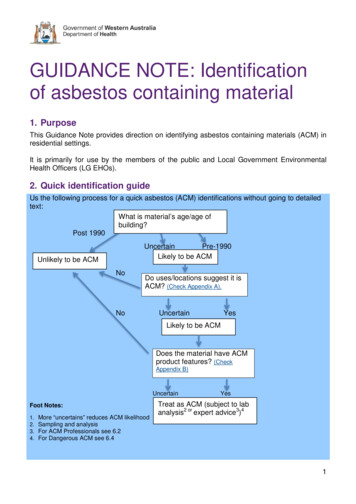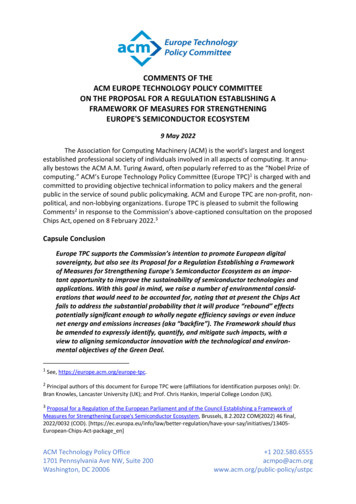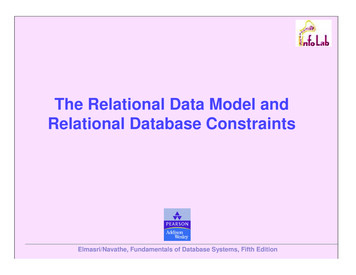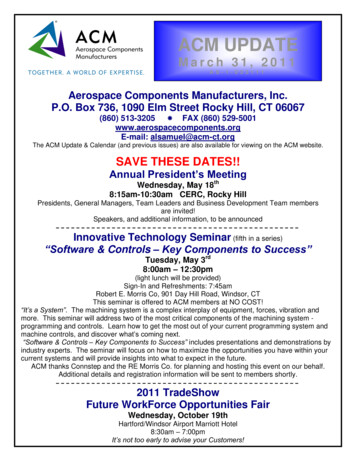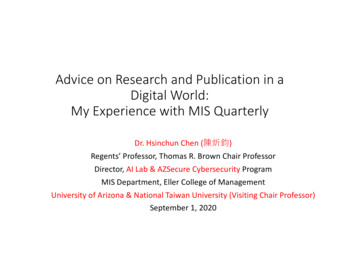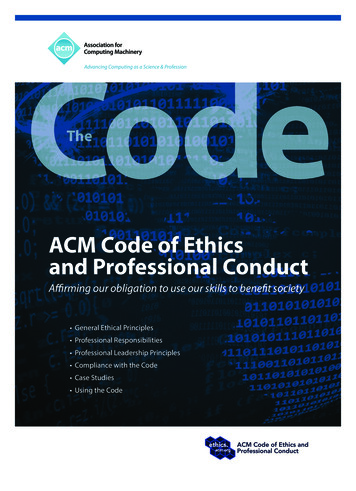
Transcription
10/4/2017Advanced Care Model(ACM) Service Deliveryand Advanced AlternativePayment ModelKhue NguyenChief Operating Officer, C-TAC Innovations1299 Pennsylvania Ave NW, Suite 1175Washington, DC 20004khuen@thectac.org 925-464-0701
October 4, 2017Physician-Focused Payment Model Technical Advisory Committeec/o Assistant Secretary of Planning and Evaluation, Room 415FU.S. Department of Health and Human Services200 Independence Ave. S.W.Washington, D.C. 20201PTAC@hhs.govRE: Letter of Support-- Advanced Care Model (ACM)Dear Committee Members,On behalf of the Coalition to Transform Advanced Care, we would like to express our utmostsupport for the accompanying proposal re-submission, the Advanced Care Model ServiceDelivery and Advanced Alternative Payment Model for consideration for a Physician FocusedPayment Model. Today, many individuals with advanced illness receive care that is fragmented,uncoordinated, or inadequate to meet their growing needs and personal wishes. The ACM isspecifically designed to meet these needs by “breaking down a range of silos between ‘curative’and palliative care, between professional groups to foster interdisciplinary practice, and betweentraditional medical and social services” (IOM Report: Dying in America).On September 7th, the Physician-Focused Payment Model Technical Advisory Committee(PTAC) provided very thoughtful feedback on the Advanced Care Model and afforded us theopportunity to resubmit a revised version of the Advanced Care Model. In the time since, wehave worked diligently, drawing upon the experience of our entire planning team in servingindividuals with advanced illness, to further refine a model that addresses the important issuesand considerations raised by the Preliminary Review Team and the larger PTAC. In particular,this submission provides updates to the beneficiary notification process, payment structure (payfor quality bonus funded by savings and shared loss with cap amounts instead of shared risk withquality threshold) and pay-for-quality measures that align with established QPP and CMMImodels.We thank you for the opportunity to re-submit our proposal and for your consideration of itsmerits. We look forward to the opportunity to work with you on behalf of our members to ensureall Americans with advanced illness, especially the sickest and most vulnerable, receivecomprehensive, high-quality, person- and family-centered care that is consistent with the goalsand values and honors their dignity.
INTRODUCTIONAbstract: Building from successful, scalable advanced illness and community-based palliativecare programs, the Coalition to Transform Advanced Care (C-TAC) proposes an advancedillness care and advanced alternative payment model, the Advanced Care Model (ACM), for aPhysician-Focused Payment Model.The Advanced Care Model provides a population health management approach for the advancedillness population, focused on the last year of life. The expected impact for ACM beneficiariesare improvements in (1) patient and family engagement, (2) shared-decision making amongpatients, families and their physicians, (3) coordinated care that aligns with patient preferences,(4) symptom management, (5) prevention of avoidable and unwanted hospitalizations or lowvalue treatment, and (6) prevention of unwanted futile care at the end of life.The ACM integrates with existing APMs and contributes to their success. By creating anintegrative model that is focused on a high-cost and high-need population, the ACM provides amechanism to risk-stratify a broader Medicare population, specifies effective care interventionsand creates additional financial incentives for existing APMs. In addition, the ACM will offermultiple pathways for organizations to incrementally add risk by participating in the ACM as anew AAPM or as a layer within the MSSP. Primary care providers and specialists can participatein the ACM APM for physician-focused payment incentives under the Quality PaymentProgram. Furthermore, the ACM meets the requirements for an advanced APM, with thepotential to qualify participating palliative care providers and specialists.The ACM meets these outcomes by delivering and ensuring comprehensive, person-centeredcare management; multidisciplinary team-based care; concurrent curative and palliativetreatment; care coordination across all care providers and settings; comprehensive advance careplanning; shared decision making with patient, family, and providers; and 24/7 access to clinicalsupport. ACM services continue until the beneficiary dies, enrolls in hospice, moves outside theservice area or chooses to dis-enroll from the ACM.The goals of the ACM payment structure are (1) to pay for improvement in quality at equal orlowered cost, (2) to convert palliative care provider’s fee schedule to a team-based, populationhealth payment structure that rewards quality, (3) to create additional incentives throughadvanced APM status for broad participation of non-palliative care specialties involved in thecare of advanced illness, (4) to utilize a pay-for-quality payment structure that incentivizesquality, and (5) to set appropriate incentives and financial risk. Ultimately, the ACM is a muchneeded, innovative advanced APM, specifically designed to improve quality for a highlyvulnerable population with advanced illness.3
Table of ContentsTable of Contents . 4I. BACKGROUND AND MODEL OVERVIEW . 1II. SCOPE OF PROPOSED PFPM . 6III. QUALITY AND COST . 10IV. PAYMENT METHODOLOGY . 15V. VALUE OVER VOLUME . 21VI. FLEXIBILITY . 22VII. ABILITY TO BE EVALUATED . 22VIII. INTEGRATION AND CARE COORDINATION . 23IX. PATIENT CHOICE . 24X. PATIENT SAFETY . 24XI. HEALTH INFORMATION TECHNOLOGY . 25XII. SUPPLEMENTAL INFORMATION . 25APPENDIX A: ACM PAYMENT METHODOLOGY ANALYSIS . 26APPENDIX B: ANALYSES OF SPENDING TARGET METHODOLOGIES CONSIDERED FORACM . 30APPENDIX C: PAY FOR QUALITY MEASURE SCORING . 34APPENDIX D: PAY FOR QUALITY BONUS PAYMENT EXAMPLE . 37APPENDIX E: DETAILED STEP-BY-STEP ACM SPENDING TARGET DETERMINATION . 39APPENDIX F: ACM PROPOSED DIAGNOSES FOR DIAGNOSIS-BASED SPENDING TARGETDETERMINATION . 44APPENDIX G: EXPERIENCE WITH ACM ELIGIBILITY CRITERIA . 45APPENDIX H: ADDITIONAL DESCRIPTION OF THE RELATIONSHIP BETWEEN PHYSICIANSAND OTHER ELIGIBLE CLINICIANS WITHIN THE ACM . 48APPENDIX I: EXAMPLE OF PARTIAL AND FULL AAPM DETERMINATION UNDER THE ACM. 49APPENDIX J: DRAFT OF ADDITIONAL INNOVATIVE FAMILY EVALUATION OF ACMSURVEY MEASURES TO BE FIELD TESTED BY CMS . 51APPENDIX K: REPRESENTATIVE ORGANIZATIONS INTERESTED IN ACMIMPLEMENTATION . 53APPENDIX L: BENEFICIARY NOTIFICATION & COMPARISONS TO OTHER MODELS . 55APPENDIX M: BENEFICIARY AND PROVIDER USER JOURNEYS. 58APPENDIX N: ACKNOWLEDGEMENTS . 61APPENDIX O: ACM PROPOSAL BIBLIOGRAPHY. 62
I. BACKGROUND AND MODEL OVERVIEWAs Baby Boomers age, a growing number will eventually experience advanced illness, when oneor more chronic conditions become serious enough that general health and functioning begin todecline and chances of recovery diminish, a process that continues to the end of life.1 Althoughthe advanced illness population contains only about four percent of Medicare beneficiaries, itaccounts for 25% of annual Medicare expenditures.2 In 2014, these patients’ mean per capitautilization over the last six months of life totaled 8.4 days in the hospital, 9.4 days in SNF, 8home health visits and 23.3 days in hospice. On average, each beneficiary saw 10.5 differentphysicians.3 Of the 2.6 million people who died in the U.S. in 2014, 2.1 million, or 8 out of 10,were people on Medicare, making Medicare the largest insurer of medical care provided to thosewith advanced illness.4This care is not just costly, but largely inconsistent with patients’ values and preferences.Although most seriously ill patients would prefer to stay in the safety and comfort of their homesnear the end of life, many are forced to cycle through a revolving door of repeatedhospitalizations.5 Hospice, originally intended to support patients at home through their lastmonths, now often consists of a few days of home-based care preceding death, tacked onto theend of a long siege of intensive inpatient treatment.6 Other care models have been proposed toremedy this, but none have yet been successful. The Medicare Care Choices Model (MCCM),for example, has had challenges enrolling patients far enough upstream because it requiresenrollees to be hospice-eligible, whereas many are not clinically or emotionally ready.The National Academy of Medicine, in its landmark study, Dying in America: Improving Qualityand Honoring Individual Preferences Near the End of Life, calls for breaking down a range ofsilos between ‘curative’ and palliative care, among professionals (e.g., to foster interdisciplinarypractice), and between traditional medical and social services.7 The Advanced Care Model(ACM) proposed here is designed to meet all these goals, as it bridges primary care and specialtyproviders, coordinates and supports a smooth progression from disease-modifying treatmenttoward a more palliative approach, and moves the focus of care for late-stage chronic illness outof the hospital and into the patient’s home and community.The ACM achieves these goals through a population health care delivery model and an advancedalternative-value-based payment model that is accountable for quality at reduced or equal totalhealth care expenditures for Medicare beneficiaries with chronic-illness in the last year of life.The ACM care delivery structure includes a network of participating physicians and othereligible clinicians, and team-based care provided across all major care settings, encompassingpalliative care providers, registered nurses, licensed social workers, and others. The ACMreplaces and expands palliative care providers’ payment for evaluation and management (E&M)services with a PMPM with downside risk for total cost of care and upside bonus for quality withset maximum payment and loss amounts. Additionally, the ACM encourages all-payer voluntaryparticipation and strengthens other APMs through payment model integration or coordination.Ultimately, the ACM is a much-needed, innovative advanced APM, specifically designed toimprove quality for a highly vulnerable population, those with advanced illness.ACM Target Population: Beneficiaries with Advanced IllnessWhile patients with greater than one-year prognosis may benefit from additional APMs, theACM is specifically designed to address the critical gap in care for advanced illness, focusing onI. BACKGROUND AND MODEL OVERVIEW1
the last twelve months of life. The intensity of the ACM services and the payment levels,including quality incentives, are tailored to this patient population. The focus on the last 12months of life allows the ACM to define an appropriate episode expenditure (see Appendix B.Analysis of Payment Spending Target Methodologies). Furthermore, the ACM reflects arecognition that a maximum 12-month duration for the PMPM could create an undesirablefinancial incentive to discharge patients or reduce the intensity of ACM services. To addresssuch a concern and preserve budget neutrality, the PMPM may extend beyond 12 months, but allPMPM payments are counted when determining the total cost of care. Over time and withexperience, we foresee that the ACM payment episode ultimately could be extended beyond thelast 12 months, with potentially lower PMPM payments for services upstream.Identification of patients with advanced illness is foundational for assessing and meeting theirhealthcare needs.891011 However, many healthcare providers feel ill-equipped to identify patientsapproaching terminal illness who are in need of interventions.12 Communicating to patients andtheir families that the patient has entered what is expected to be the last year of life is also verydifficult for many providers.13 Focusing on this gap, improving identification and implementingneeded services to fill the care gap is a crucial first step for this vulnerable population.14 TheACM patient identification criteria utilize the most up-to-date research and best practicescurrently being implemented by the leading advanced care programs across the country toidentify patients with advanced illness who are likely to be in their last year of life.When used in isolation, single disease-centered tools have been shown to have low prognosticcapacity,15161718 192021 specifically within geriatric populations with multiple chronic conditions.22However, two comprehensive systematic reviews of MEDLINE databases (n 457) confirm thatcombinations of acute care utilization,23242526 functional status,27282930 and nutritionalstatus.3132333435 can accurately signal advanced illness across both cancer and non-cancerdiagnoses.3637 In addition, 3 performance scales are also found to be adjunct to the indicatorsabove: the Eastern Cooperative Oncology Group (ECOG) Performance Status,38 the KarnofskyPerformance Scale (KPS)39 and the Palliative Performance Status (PPS).40Used collectively, these criteria enhance accuracy and provide objective guidance for ACM’sparticipating physicians and other referring clinicians on timely identification of advancedillness. The references listed in this section, including the systematic reviews of MEDLINEdatabases (Salpeter 2011, 2012), the Textbook of Palliative Medicine and Supportive Care,41 andthe evidence-based practice guideline Palliative Care for Adults,42 support the specific clinicalcriteria values and ranges laid out in the ACM patient identification criteria (Table 1).To further validate and enhance accurate identification of beneficiaries with advanced illness, thesurprise question is used in addition to the objective criteria described above. The surprisequestion has been shown to be more prognostic of patient death than age, cancer stage, cancertype, or time since diagnosis and a very useful tool to aid in the systematic identification ofpatients at a high risk of death.43 93% of providers felt that the surprise question is an appropriatetrigger to identify those patients approaching the end of life.44 In another study, survivalprognosis by providers using the surprise question and survival at one year correlatedsignificantly.45 The combination of accuracy and simplicity makes the surprise question animportant tool for identifying patient selection.46I. BACKGROUND AND MODEL OVERVIEW2
Together, the objective clinical criteria combined with the surprise question help balance bothaccuracy and comprehensiveness of advanced illness identification and align with the mostrecent research and best practices being implemented across the country.Table 1: Description of ACM Criteria1.2.Acute CareFunctionalUtilizationDecline2 hospitalizations inthe last 12 monthsor1 ER visit & 1hospitalization inthe last 6 monthsNew,irreversibledependence inat least 1 ADLin the last ation viaSurpriseQuestionInvoluntarylean bodyweight loss 5% in the last3 monthsPPS 60Would you besurprised if thepatient died inthe next 12months?orKPS 60oror2 ER visits in thelast 3 monthsECOG 3Figure A. ACM Eligibility Determination ProcessBeneficiaries are eligible for the ACM if they meet acriterion in two of the four component categories(Acute Care Utilization, Functional Status,Nutritional Status or Performance Scales) followedby validation with the surprise question, asillustrated in Figure A.Appendix G provides further evidence to supportthe application of the ACM criteria (Sutter AIM &Aspire).ACM Care Delivery Model: Patient’s PerspectiveThe ACM is envisioned with the patient’sperspective in mind. The ACM’s enhanced packageof care delivery services is patient-centered,reflecting engagement with the patient and thepatient’s choices, preferences, and values. Theseenhanced ACM services embody a “team of teams”approach, employing interdisciplinary teams that canfunction across inpatient, outpatient and homesettings. As detailed below, the ACM’sinterdisciplinary team is charged with providingI. BACKGROUND AND MODEL OVERVIEW3
comprehensive, person-centered care management including personalized and evolvingconcurrent “curative” and palliative services, systematic advance care planning, patient andfamily engagement, and 24/7 access to a clinician. The ACM interdisciplinary care team must include a provider with board-certifiedpalliative care expertise, a registered nurse and a licensed social worker, and may includeother clinicians practicing within their scope of licensure as well as non-clinicians.Comprehensive care management is defined as care coordination and case managementof the beneficiary’s total healthcare needs, both curative and palliative, encompassing allservices including physicians and other eligible clinicians, hospital, post-acute, and socialservices.Systematic advance care planning is defined as a person-centered, ongoing process inwhich patients, their families, and their healthcare providers reflect on the patient’s goals,values, and beliefs, discuss how they should inform current and future medical care, andultimately, use this information to accurately document future health care choices, afteran exploration of the patient and caregiver’s knowledge, fears, hopes, and needs.47Specifically, the advance care planning should be initiated and routinely revisited, at thebeneficiary’s own pace and systematically engages with all key stakeholders includingthe beneficiaries, their families and their treating providers.Personalized and evolving concurrent curative and palliative services are defined as theongoing provision of palliative/comfort-based care as well as coordination and promotionof evidence-based disease-modifying treatments that align with the patient’s evolvingpersonal preferences.Patient and family engagement is defined as shared decision-making between theadvanced illness beneficiary/caregivers/family and the ACM care team in designing andimplementing the ACM care plan.After identification, discussion of advanced illness, and referral by a clinician involved in thebeneficiary’s health care, the beneficiary would receive a face-to-face visit by an ACM clinicianto assess eligibility and provide notification of ACM services. The notification providestransparency about the ACM to beneficiaries. The beneficiary notification would include anexplanation of the ACM services and payment structure, a description of advanced illness andACM eligibility criteria (including prognosis), the possible impact on beneficiary care, astatement that the beneficiary retains the right to opt out and freedom of choice regardingproviders and services, an explanation of how patients can access care records and claims data, astatement that all existing Medicare beneficiary protections continue to be available to thebeneficiary, and a list of providers and suppliers of the ACM entity. Upon confirmation ofeligibility by the ACM clinician to the referring provider, the beneficiary is enrolled in the ACMunless the beneficiary chooses to opt out of the services. Enrollment status would becommunicated to the beneficiary’s primary care providers and active specialists, assuring thesephysicians an ongoing role in directing the beneficiary’s care.Within 14 days of enrollment, the beneficiary will have received advance care planning servicesby the ACM team that would include exploration of goals, values and preferences and continueddiscussions of disease process and prognosis (Table 2. Quality Measures). Early discussion ofpatient’s possible prognosis is important in facilitating patients and their families’ planning fortheir future care. Research shows that most patients have preferences for how they want to betreated and how their affairs are to be settled.484950 Successful advance care planning ultimatelyI. BACKGROUND AND MODEL OVERVIEW4
gives beneficiaries and their family greater control, and less distress and decision-makingconflict.51 Furthermore, a plan to address advanced illness care progression can further preventtriggering events in the patient’s life that can lead to rapid decline.52ACM services would be provided on an ongoing basis through a mixture of face-to-face andtelephonic encounters that would be proactively deployed based on beneficiaries’ current andanticipated needs. The ACM care team would coordinate care with the beneficiary’s regularphysicians and episodic providers such as hospital or home health care. During the ACM care,beneficiaries may choose to discontinue ACM services if they wish. In addition, beneficiariesmay continue to access traditional services under their Medicare benefit and patient choice ismaintained. ACM services would continue until the beneficiary dies, is enrolled in hospice, disenrolls, or moves outside the ACM entity’s service area.ACM Care Model: Health Care Provider’s PerspectiveThe ACM is available to a wide range of Medicare provider entities (primary care physicians andspecialists, hospitals, health systems, hospices, home health and others), providing newopportunities for organizations that have not been central to the Medicare Shared SavingsProgram. Furthermore, the ACM is designed to support physician engagement regardless ofparticipation status.The ACM care delivery structure consists of two core components: (1) participating physiciansand other eligible clinicians and (2) the interdisciplinary team. Advanced illness patients ofparticipating physicians and other eligible clinicians are eligible for the ACM services. Theparticipating providers and other eligible clinicians may include primary care and specialists whoare involved in the patient’s care, and participants can be added on an ongoing quarterly basis.The interdisciplinary team is responsible for the implementation of the ACM care deliveryservices.Advanced illness patients are identified through referral from participating physicians and othereligible clinicians, as well as by other health care clinicians involved in the patient’s care. Also,the ACM interdisciplinary care team can collaborate and assist health care providers involved inthe beneficiary’s care in their identification process. Eligibility is confirmed by the participatingphysicians and other eligible clinicians by validating with the surprise question, in addition to thepresence of other quantified clinical eligibility criteria.Primary care providers and active treating physicians are informed of the ACM enrollmentstatus. Regardless of their participation status, these providers will continue to have full controlover how they choose to care for their patients and how they choose to interact with the ACMinterdisciplinary team and be involved in the services offered, including comprehensive caremanagement, concurrent care and advance care planning (see Appendix M: Beneficiary andProvider User Journeys).ACM services continue until the beneficiary dies, enrolls in hospice, moves outside the servicearea or chooses to discontinue the ACM because they no longer have advanced illness or nolonger want the service as covered in detail below: Discharge Process to Hospice: The beneficiary and family members will have hadmultiple conversations, with one another and their health care team, regarding the hospicebenefit. The beneficiary will have chosen to elect hospice through shared-decisionmaking with their physicians and the ACM team. The beneficiary will have been notifiedthat the ACM team has coordinated the arrangements for hospice care with theI. BACKGROUND AND MODEL OVERVIEW5
beneficiary's choice of hospice provider, and that the ACM care program will end whenhospice care begins. The discharge process is completed once the beneficiary is enrolledin hospice. The beneficiary will have given information about how to re-enter the ACMprogram if they no longer want or need hospice. Discharge Process When Patient Moves Outside of the Service Area: The beneficiarywill have been notified by the ACM team that the ACM service will end and that theACM patient records have been shared with their new PCP. Also, the beneficiary willhave received a list of recommendations by the ACM team about any other ACM orsimilar programs in the patient’s new service area and steps to take with their new careteam to support a smooth transition. Discharge Process When Patient Chooses to Discontinue the ACM because they nolonger have advanced illness or no longer want the service: The beneficiary will haveparticipated in shared decision making with their physicians and the ACM team to reachdetermination that their condition has improved and they no longer have advanced illnessand or no longer want the ACM services. The beneficiary will have been notified by theACM team that the ACM services will end and that the ACM care summary have beenshared with their PCP and active specialists. The beneficiary will have received a list ofrecommendations by the ACM team of steps to take to maintain their health and when toconsider re-accessing the ACM care in the future.II. SCOPE OF PROPOSED PFPMThe ACM is a new advanced APM, specifically designed to improve quality and cost outcomesfor advanced illness and end-of-life care. The ACM is available to a wide range of Medicareprovider entities (physician practices, hospitals, health systems, hospices, home health andothers). In addition, the ACM supports collaboration with other ancillary organizations such ashealth plans, care management and telehealth providers, EMT services and social serviceorganizations. The ACM entity must meet the following requirements:1. The entity must be a Medicare provider2. The entity must have a system for administering billing/financial transactions for theACM APM between the ACM entity and CMS,3. The entity must have a system to distribute payments, or shared risks between theACM entity and participating physicians, other eligible professionals, and/or otherhealth care organizations,4. The entity must have a data system to generate and submit the necessary reportsrequired by the ACM and to share reports generated from the ACM entity and CMSto participating physicians, eligible professionals, and/or other health careorganizations,5. The entity must have appropriate licenses to deliver the ACM services, eitherdirectly or under arrangements with other providers,6. The entity must have a defined network of participating physicians and other eligibleprofessionals with a reasonable projected advanced illness patient volume to operatethe ACM services7. The entity must demonstrate feasibility of the ACM entity, participating physicians,other eligible professionals and/or other health care organizations to assumefinancial risk and be accountable for quality, andII. SCOPE OF PROPOSED PFPM6
8. The entity must satisfy, directly or through arrangements, all ACM service andoperational requirements.Impact of the ACM on Physician or Other Eligible CliniciansThe ACM promotes broad participation across diverse physician practices, including employed,independent, and small physician practices. First, most medical specialties are involved inadvanced illness care and therefore are able to participate in the ACM. In fact, advanced illnessbeneficiaries on average see 10.5 different physicians.53 These physicians, across multiplespecialties, can furnish the ACM care delivery services directly or participate in an ACM entitythat
Payment Model Khue Nguyen Chief Operating Officer, C-TAC Innovations 1299 Pennsylvania Ave NW, Suite 1175 Washington, DC 20004 . shared decision making with patient, family, and providers; and 24/7 access to clinical . and between traditional medical and social services.7 The Advanced Care Model (ACM) proposed here is designed to meet all .

